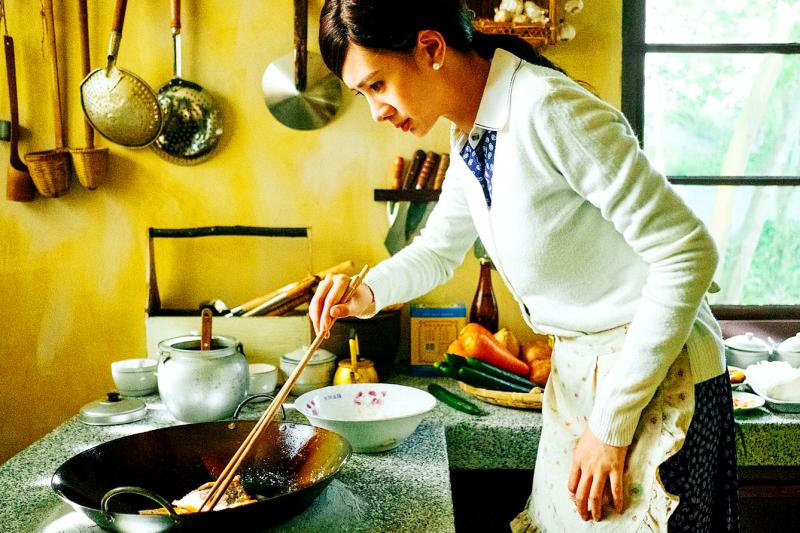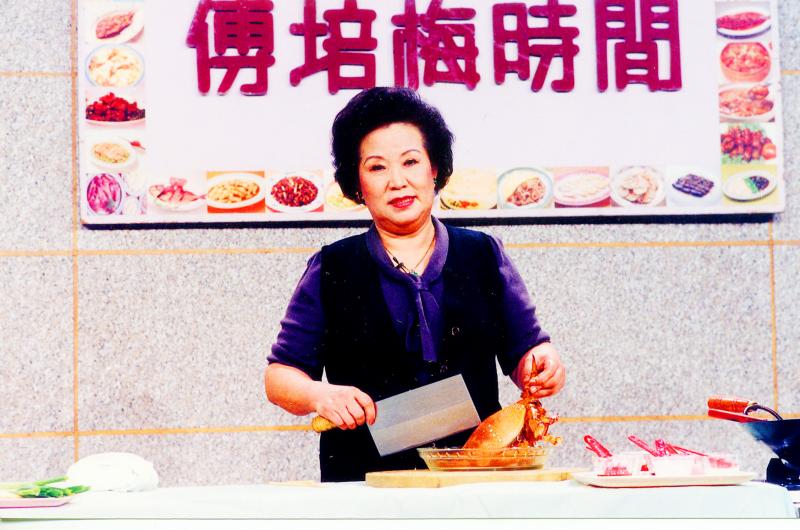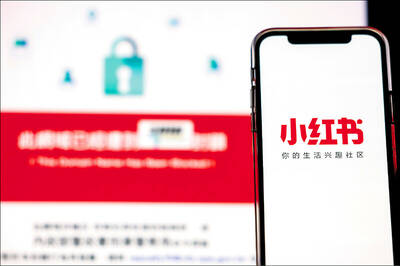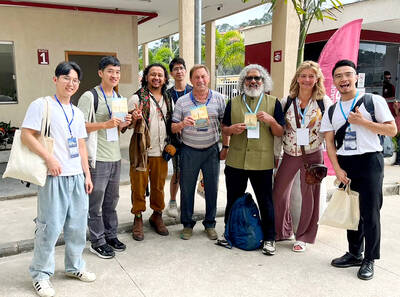Sept.13 to Sept.19
Fu Pei-mei (傅培梅) leafed through the telephone book and jotted down the address of every prestigious Taipei restaurant she could find. She then mailed out her request: “Seeking famous chefs to learn cooking from, high pay.”
A star student from a wealthy family in Japanese-occupied Manchuria, Fu never bothered with cooking growing up. After fleeing her hometown at the age of 15 due to the Chinese Civil War, she eventually ended up in Taiwan, where she held a number of clerical jobs in Taipei. She enjoyed office work, especially since the company provided meals.

Photo: Wu Chih-wei, Taipei Times
This was the 1950s, however, and Fu soon left her job to marry fellow refugee Cheng Shao-ching (程紹慶), whom she was introduced to on a blind matchmaking date. She described Cheng as a reserved, patriarchal man.
“I was educated in a Japanese school where they taught us that women should be obedient, and I also watched my mother also dedicate her life to serving my father,” she writes in her autobiography, What She Put On The Table (五味八珍的歲月). “So I did not question a lot of the things that happened then. I never considered that perhaps the times were changing, and this mentality may no longer have been acceptable.”
Part of Fu’s duties as a housewife was cooking — but she barely knew how. She attempted to hone her craft several times, but never got around to it until her children were both in school. Cheng was having guests over more often, and it was customary for them to pay the host for food and drink. He criticized Fu’s cooking often, which drove the competitive Fu to seek help from the best.

Photo: Chen You-ying, Taipei Times
Several chefs responded to Fu’s message. She learned quickly, and eventually became one of the nation’s most celebrated chefs. In March 1997, she won a Golden Bell Award for her beloved cooking show that was immensely popular in a rapidly modernizing Taiwan.
QUICK RISE
By 1961, Fu had become skilled enough to offer private lessons in the courtyard of her residence. Taiwan Television (台視), the nation’s first terrestrial station, launched a year later, and was recruiting a host for the cooking segment on their Happy Family (幸福家庭) program. Fu had several well-connected students, and one of them got her a meeting with the producer. In December 1962, Fu went on live camera for the first time.
It was a disastrous experience, as Fu realized that she had forgotten her knife right before shooting. She rushed to the station cafeteria and grabbed one, but it was so dull it took her much effort and time to make simple cuts. She went way over her allotted time, and the camera cut off before she could say goodbye to the audience.
Fu thought she had blown it, but to her surprise, the station invited her back the following week after viewers praised her performance. This time, she nailed it with a highly-difficult braised sea cucumber dish.
Two years later, Fu was given her own weekly show, which she also produced. She explored both Western and Chinese cuisines, and invited American guests on special occasions to demonstrate how to roast turkey and make hamburgers.
Fu’s name reached the West after the release of her English-Chinese bilingual cookbook in 1969. She was compared to Julia Child for the first time in a 1971 article by New York Times reporter Raymond Sokolov, who noted that Fu introduced Chinese cooking to America like Child did with French cuisine.
In 1977, Fu appeared on a foreign program for the first time on Japan’s Fuji TV. Attending Japanese school until she was 15, Fu could still speak Japanese. The popular show went on for five years, won several local awards and earned Fu honorary residentship from the government. Over the years, she traveled extensively as part of the government’s early efforts to combat its international isolation through soft power initiatives.
Fu’s last show, Fu Pei-mei Time (傅培梅時間), debuted in 1986, which featured her making five minute-meals five days a week. It was the first time her name was included in the title of her show, and it spawned a cookbook series with the same name. It was stressful to have to perfect a meal in such a short time on live television, but Fu writes that it was immensely rewarding.
A PHENOMENON
Wang Yuan-ju (王源如) writes in the study, “The Fu Pei-mei phenomenon: economic and social changes in 1960s Taiwan” (傅培梅現象: 60年代台灣與社會變遷), that people were increasingly using electric kitchen appliances in the early 1960s to save time. It also became a status symbol in a growing economy, as everyone wanted to have the latest gadget, from electronic ovens to washing machines.
The time was right for Fu’s show, as Taiwan was in the early stages of industrialization and television ownership was on the rise. People also began to live in apartments with built-in kitchens. Many women were working in factories, and needed to cut down their food preparation time at home. Being unfamiliar with fridges, gas stoves and rice cookers, Fu taught them all they needed to know.
Her show was the first in the nation to employ step-by-step, quantified instructions using modern technology. Its ratings soared, leading to a proliferation of similar programs by rival channels.
“Fu was a beloved figure whose warm demeanor and expert lessons helped countless home cooks become more confident in the kitchen — and make delicious traditional meals too,” the description read when Google made Fu its doodle on Oct. 1, 2015 to mark what would be her 84th birthday.
The doodle called her a “leading authority on Chinese cooking” and features two her best known recipes: fried prawn slices with sour sauce (醋溜明蝦) and the Cheng Family meat dish (程家大肉).
Other industry endeavors include designing airplane meals for China Airlines and serving as technical advisor for instant noodle flavoring for Uni-President Enterprises Corp (統一企業).
Fu tried to retire in 1993 on the show’s 30th anniversary, but TTV begged her to stay for several more years. She authored over 50 cookbooks, presenting an estimated 4,000 distinct dishes. In 1998, she was listed among Commonwealth Magazine’s (天下) 200 most influential professionals in Taiwanese history. She died on Sept. 16, 2004.
The entry read: “In those tougher times, Fu Pei-mei always relieved our hunger and worries, and also encouraged us to pay more attention to what we ate and to enjoy life more. In those times of austerity, Fu Pei-mei warmed the stomachs of every Taiwanese.”
Taiwan in Time, a column about Taiwan’s history that is published every Sunday, spotlights important or interesting events around the nation that either have anniversaries this week or are tied to current events.

Most heroes are remembered for the battles they fought. Taiwan’s Black Bat Squadron is remembered for flying into Chinese airspace 838 times between 1953 and 1967, and for the 148 men whose sacrifice bought the intelligence that kept Taiwan secure. Two-thirds of the squadron died carrying out missions most people wouldn’t learn about for another 40 years. The squadron lost 15 aircraft and 148 crew members over those 14 years, making it the deadliest unit in Taiwan’s military history by casualty rate. They flew at night, often at low altitudes, straight into some of the most heavily defended airspace in Asia.

This month the government ordered a one-year block of Xiaohongshu (小紅書) or Rednote, a Chinese social media platform with more than 3 million users in Taiwan. The government pointed to widespread fraud activity on the platform, along with cybersecurity failures. Officials said that they had reached out to the company and asked it to change. However, they received no response. The pro-China parties, the Chinese Nationalist Party (KMT) and Taiwan People’s Party (TPP), immediately swung into action, denouncing the ban as an attack on free speech. This “free speech” claim was then echoed by the People’s Republic of China (PRC),

Many people in Taiwan first learned about universal basic income (UBI) — the idea that the government should provide regular, no-strings-attached payments to each citizen — in 2019. While seeking the Democratic nomination for the 2020 US presidential election, Andrew Yang, a politician of Taiwanese descent, said that, if elected, he’d institute a UBI of US$1,000 per month to “get the economic boot off of people’s throats, allowing them to lift their heads up, breathe, and get excited for the future.” His campaign petered out, but the concept of UBI hasn’t gone away. Throughout the industrialized world, there are fears that

Like much in the world today, theater has experienced major disruptions over the six years since COVID-19. The pandemic, the war in Ukraine and social media have created a new normal of geopolitical and information uncertainty, and the performing arts are not immune to these effects. “Ten years ago people wanted to come to the theater to engage with important issues, but now the Internet allows them to engage with those issues powerfully and immediately,” said Faith Tan, programming director of the Esplanade in Singapore, speaking last week in Japan. “One reaction to unpredictability has been a renewed emphasis on